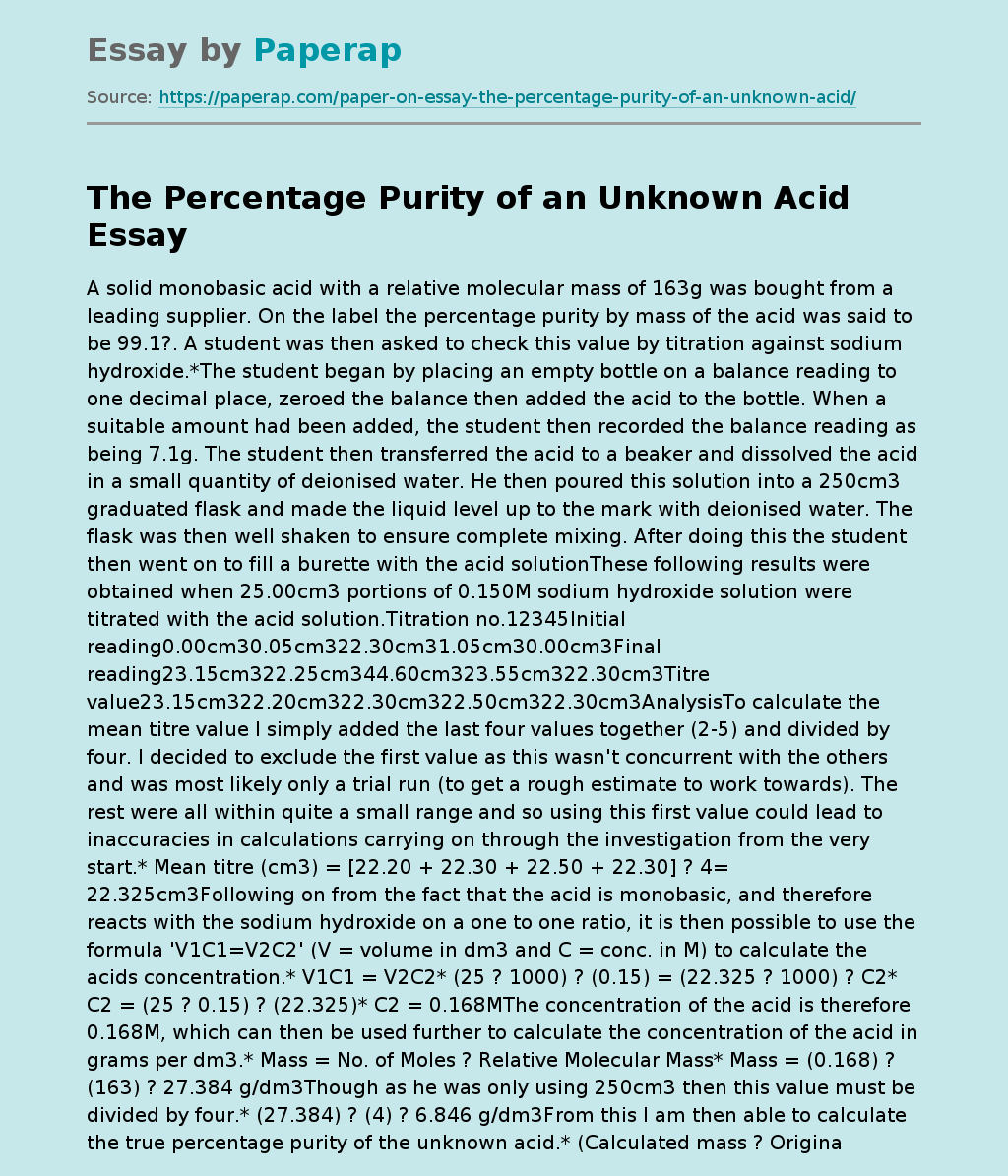A solid monobasic acid with a relative molecular mass of 163g was bought from a leading supplier. On the label the percentage purity by mass of the acid was said to be 99.1?. A student was then asked to check this value by titration against sodium hydroxide.*The student began by placing an empty bottle on a balance reading to one decimal place, zeroed the balance then added the acid to the bottle. When a suitable amount had been added, the student then recorded the balance reading as being 7.
1g. The student then transferred the acid to a beaker and dissolved the acid in a small quantity of deionised water. He then poured this solution into a 250cm3 graduated flask and made the liquid level up to the mark with deionised water. The flask was then well shaken to ensure complete mixing. After doing this the student then went on to fill a burette with the acid solutionThese following results were obtained when 25.
00cm3 portions of 0.150M sodium hydroxide solution were titrated with the acid solution.Titration no.12345Initial reading0.00cm30.05cm322.30cm31.05cm30.00cm3Final reading23.15cm322.25cm344.60cm323.55cm322.30cm3Titre value23.15cm322.20cm322.30cm322.50cm322.30cm3AnalysisTo calculate the mean titre value I simply added the last four values together (2-5) and divided by four. I decided to exclude the first value as this wasn’t concurrent with the others and was most likely only a trial run (to get a rough estimate to work towards). The rest were all within quite a small range and so using this first value could lead to inaccuracies in calculations carrying on through the investigation from the very start.
* Mean titre (cm3) = [22.20 + 22.30 + 22.50 + 22.30] ? 4= 22.325cm3Following on from the fact that the acid is monobasic, and therefore reacts with the sodium hydroxide on a one to one ratio, it is then possible to use the formula ‘V1C1=V2C2′ (V = volume in dm3 and C = conc. in M) to calculate the acids concentration.* V1C1 = V2C2* (25 ? 1000) ? (0.15) = (22.325 ? 1000) ? C2* C2 = (25 ? 0.15) ? (22.325)* C2 = 0.168MThe concentration of the acid is therefore 0.168M, which can then be used further to calculate the concentration of the acid in grams per dm3.* Mass = No. of Moles ? Relative Molecular Mass* Mass = (0.168) ? (163) ? 27.384 g/dm3Though as he was only using 250cm3 then this value must be divided by four.* (27.384) ? (4) ? 6.846 g/dm3From this I am then able to calculate the true percentage purity of the unknown acid.* (Calculated mass ? Original mass) ? 100 = ……?* ( 6.846 ? 7.1 ) ? 100 = 96.4?By this method the percentage purity was found to be 96.4? and not 99.1?.Apparatus error* Balance ? 0.1g ? (0.1 ? 7.1) ? 100 = 1.41?* 250cm3 volumetric flask ? 0.5cm3 ? (0.5 ? 250) ? 100 = 0.2?* 25cm3 pipette ? 0.05cm3 ? (0.05 ? 25) ? 100 = 0.2?* Burette ? 0.15cm3 ? (0.15 ? 22.325) ? 100 = 0.67?* Total Apparatus Error = 2.48?EvaluationI calculated that the percentage purity of the unknown acid was 96.4? and not 99.1?. This is a 2.7? difference and assuming that I was wrong and they were right, this discrepancy between my percentage purity and the figure supplied could have been caused by one or more of the reasons below.Each piece of equipment being used for the experiment carries with it its own percentage error. As I have already shown the maximum overall apparatus error for this experiment was 2.48?, this could have contributed alot towards the difference between my value and the one given.Another reason for some concern is the students’ method for preparing the acid solution and his titration technique. When preparing the acid solution he weighed out the acid using a balance that only read to one decimal place, which isn’t quite accurate enough. He also forgot that after emptying the acid from the weighing bottle that he must also reweigh the bottle and take the difference (this meaning he didn’t really know exactly how much acid he dissolved).The students titration technique was also at fault with him only filling the burette correctly twice out of five titrations. There is nothing mentioned either about him rinsing the burette or the pipette beforehand with the acid and sodium hydroxide respectively. This should always be done before attempting a titration to remove any impurities from the apparatus.After examining the students method I’m not that surprised my calculated percentage purity was a bit off as there were plenty of things that could have caused inaccuracy in the experiment. If the student was to attempt the whole thing again I would urge him to listen to the improvements listed below:* Use a balance that reads to two decimal places instead of one.* Weigh the bottle and acid together, then the bottle by itself and takethe difference.* Make sure all washings are transferred to the volumetric flask.* When filling the burette make sure to fill it right to the top (0.00cm3) each time.
The Percentage Purity of an Unknown Acid. (2019, Jun 20). Retrieved from https://paperap.com/paper-on-essay-the-percentage-purity-of-an-unknown-acid/

